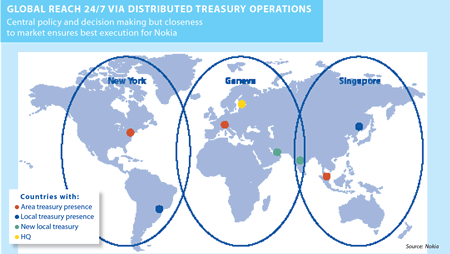By Anne Friberg
Cost cutting in hard times usually prompts MNCs to consider further consolidation of treasury. At last October’s EuroFinance in Barcelona, however, a comparison of two fundamentally differently organized companies, Tetra Laval and Nokia, revealed that the Best-In-Class label doesn’t necessarily apply to the most completely centralized treasury. Thus, the impulse to consolidate everything may not be the right one.
TETRA LAVAL: SELECTIVE CENTRALIZATION
One way to balance the urge to consolidate with decentralized execution is to selectively do both in combination. This is exemplified in the approach of Tetra Laval, a Swedish packaging giant, whose largest markets are China and Brazil.
In introducing his company, Treasurer Aidan Clare observed that because of its entrepreneurial history—young managers were sent to emerging markets to start businesses with few resources — it is a “global group with decentralization as default unless there is a strong rationale for centralization.”
Citing economies of scale, control and the ability to leverage expertise, Mr. Clare has been working since 2005 to centralize treasury’s critical functions. These include financing, FX, interest-rate and cash management; projects; accounting and middle and back office.
A combination approach. Mr. Clare convinced internal stakeholders that continued treasury and finance decentralization brought along potentially ineffective controls and lack of governance, and that a combination of centralized and local decision-making was more appropriate for Tetra Laval (see table below).

|
CENTRALIZATION AND SATISFACTION Among corporate practitioners, treasury satisfaction is generally closely related to the level of centralization: higher is better. A poll of the corporate audience at the Barcelona EuroFinance showed that while 28 percent considered themselves to be decentralized, only 5 percent were happy with that; 23 percent were looking to increase treasury centralization.
Thus, treasury’s ability to add value through close communication with business units has become as important to treasury’s satisfaction. |
As an example: “Funding decisions should be taken where the funds are needed,” Mr. Clare noted, but in accordance with policy guidelines and coordinated with central treasury. Execution is a decentralized responsibility, not least because of the often cumbersome loan documentation in emerging markets, which would not be manageable at the lean nine-people HQ treasury.
Functions like FX, interest rate and cash management, on the other hand, are centrally managed, which is driven by the need for savings and security. Treasury and ops jointly agree on the methods and structure for these activities and some tasks are, by necessity, performed locally.
Even where activities are largely centralized, “treasury does not act independently,” said Mr. Clare, and admitted that some treasury decisions can have a negative impact on the operations’ bottom line. Thus, operations will want input. But the key is that treasury has a clear mandate and a global policy that is agreed on globally and endorsed by the Board.
NOKIA: CENTRALIZED, BUT REGIONAL
Nokia’s history and development point to an entirely different type of company. While JVs and acquisitions may challenge centralization efforts, according to treasurer Kristian Pullola, the mobile phone, services and network infrastructure powerhouse is in essence a centralized business which drives the treasury to take a similar path.
By centralizing the “ownership” of all financial risk to a value-add-oriented treasury and emphasizing the importance of understanding the business, Nokia has attracted top talent who grasp the implications of their decisions on company positions and performance.
Stripping out financial risk from the business units mean that the 80-people strong treasury handles FX risk; all corporate finance; and cash management, including in-house banking and a payment factory, the one “pipe” through which most payments are executed. Central management by treasury also goes beyond the “classic” core functions to include customer finance and insurance as well.
Geography limits and rewards. Because the world is not flat and all in one time zone, there are limits to how far even the most determined centralizer can go. Nokia decided to forgo 100 percent treasury centralization (with the control and close team work it would bring) in favor of:
-
Best execution. By spreading its execution talent to regional treasury centers in Europe, the Americas and Asia (see illustration below), treasury can ease treasury-to-business communication, and ensure 24-hour global coverage and ability to execute trades at the most liquid times in each market. Access to local markets is particularly important in these turbulent times because “even in times of crisis, there are pockets of liquidity,” said Mr. Pullola. The key is to have the flexibility to tap the most efficient markets from time to time. “The optionality is beneficial.”
-
Local customization. Centralization generally reduces the amount of local “adjustments” and departures from the central/standard model that treasury can support. With a centralized but “distributed” treasury close to the businesses, Nokia can add “ local customization” (with some help from banks) to make treasury processes run smoother, particularly in its most crucial markets, while it forgoes this in less important ones.

In Nokia’s case, treasury seeks to balance centralization with regional execution to optimize activities across the globe. Tetra Laval, conversely, appears to have found a central-to-local balance to fit its tradition of supporting entrepreneurial business decisions and an emerging-markets footprint favoring local needs. Both examples suggest a best-in-class treasury be properly aligned with its organization and mission, while balancing efficiencies and control considerations, rather than be centralized for its own sake.
|
A SWIFT RESCUE? A global treasury organization would be nowhere without standardized technology and at no time have the stars been aligned so favorably for global standards.
These and other factors will open up the ability for treasuries to (a) adapt more easily to local cash management standards aligned with SWIFT; (b) increase processing economies of scale; and still (c) be nimble enough to add and remove bank counterparties easily. |